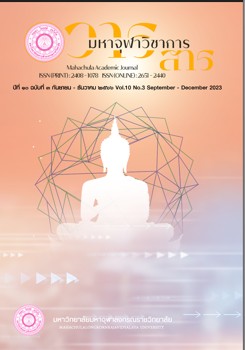The Formula Taddhita in the Laghusiddhāntakaumudī and the Niruttidīpanī : An Analytical Study
Main Article Content
Abstract
This research aims to study two objectives. These are : (1) to study the history and background of the Laghusiddhāntakaumudī and Niruttidīpanī scriptures (2) to analyze the presentation of the Taddhita formula in the scriptures. This research is a documentary investigation research. The research methods process consists of the following steps, collecting and categorizing data from relevant documents analyzing the form of presentation of the Taddhita formula in the two scriptures and summarizing the research results. The research found that the Laghusiddhāntakaumudī scripture was composed by Varadarāja in the 11th century as a scripture explaining the Pāṇini Grammar Sutra. On the other hand, the Niruttidīpanī was composed by Shin Ńāṇadhaja or Ledi Sayadaw for the purpose of explaining the Moggallāna Grammar Sutra. Both of these scriptures have a similar purpose. The structure of each formula in both the Laghusiddhāntakaumudī and Niruttidīpanī may not be complete as in the generally accepted Sanskrit and Pali phrases. Content is organized in a similar way, with the Laghusiddhāntakaumudī arranged by the names of Taddhita and the Niruttidīpanī arranged by groups of Taddhita. The formula for writing the Taddhita in both manuscripts is similar in that they are written according to the common grammar used by grammarians. The formula in a concise and organized manner, making the meaning clear, as well as, easy to remember. The Taddhita in both manuscripts starts with one word and as it progresses use words. Both manuscripts are primarily based on a principle-based formula, as they discuss the method of creating meaning and factors of Taddhita. This is considered one method.
Article Details

This work is licensed under a Creative Commons Attribution-NonCommercial-NoDerivatives 4.0 International License.
References
จิรพัฒน์ ประพันธ์วิทยา. “การเข้ามาของภาษาบาลีและสันสกฤตในประเทศไทย”. ในการสัมมนาเรื่องอิทธิพลของภาษาบาลีและสันสกฤตที่มีต่อภาษาไทย. คณะมนุษยศาสตร์: มหาวิทยาลัยเชียงใหม่, ๒๕๒๒.
จำลอง สารพัดนึก. ประวัติวรรณคดีสันสกฤต เล่มที่ ๑. กรุงเทพมหานคร: สำนักพิมพ์มหาวิทยาลัยรามคำแหง, ๒๕๔๖.
พระคันธสาราภิวงศ์. ปทรูปสิทธิมัญชรี คัมภีร์อธิบายปทรูปสิทธิ เล่ม ๑. กรุงเทพมหานคร: หจก.ไทยรายวันการพิมพ์, ๒๕๔๗.
พระญาณธชเถระ. นิรุตติทีปนิ. ตรวจชำระโดย พระธรรมโมลี (สมศักดิ์ อุปสโม) พระมหานิมิตร ธมฺมสาโร. กรุงเทพมหานคร: หจก.ไทยรายวันการพิมพ์, ๒๕๔๘.
พระเทพเมธาจารย์ (เช้า ฐิตปญฺโญ). ตำราเรียนไวยากรณ์กัจจายนสนธิ. ธนบุรี: โรงพิมพ์ประยูรวงศ์, ๒๕๐๖.
พระวชิรพุทธิเถระ. นฺยาสปกรณํ. ลำปาง: วัดท่ามะโอ, ๒๕๒๒.
Bode, M.H. The Pali Literature of Burma. London : Retypeset and reprinted by BPS, 2013.
Geiger, W. Pali Literature and Language, Trans. Delhi : Munshiram Manoharlal Publishers, 1996.
James R. Ballantyne, LL.D. The Laghukaumudi : A Sanskrit Grammar by Varadaraja. Bannares: E.J.Lazarus & Co, 1849.
Joshi, Mahadev N. and Shastri, Veneemadhava. New Sanskrit Grammar & Composition. Varanasi: Chaukhambha Prakashan, 2011.
Macdonell, A.A. A History of Sanskrit Literature. Delhi: Munshiram, 1972.
Winternitz, M. History of Indian Literature. Delhi: Motilal Banarsidass, 1985.


